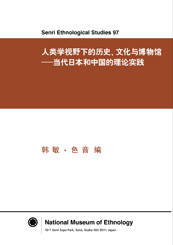Senri Ethnological Studies (SES)
 No. 97 Anthropological Perspectives on History, Culture and Museum: Theoretical Practice in Japan and China
No. 97 Anthropological Perspectives on History, Culture and Museum: Theoretical Practice in Japan and China
March 12, 2018 Publication
Edited by HAN Mi, SE Yin
back numbersCONTENTS
Introduction
History, Culture and Museum: Theoretical Practice of Anthropologists in Japan and China ………………HAN Min, SE Yin
History, Culture and Museum: Theoretical Practice of Anthropologists in Japan and China ………………HAN Min, SE Yin
Part 1 Anthropology, Fieldwork and Museum
1. My Fieldworks and Investigation Methods
………………SUENARI Michio
2. Anthropological Interaction between Japan and China: In the Case of the National Museum of Ethnology
………………HAN Min
3. Historical and Cultural Representation of the Heje-Nanai Ethnicity in Museums: A Case Study on the People of Geiker hala in the Aoqi Village
………………SASAKI Shiro
4. Ethnological Collecting Work of Ethnic Relics: Cultural Relics Collected by the Institution of Ethnology and Anthropology of the Chinese Academy of Social Science
………………WUYUNGERILE
5. Exploring and Analyzing the Khorchin Mongolian Shamanistic Formative Arts
………………SE Yin
6. Sami Shaman Drums: The Important Carriers and Symbols of Sami Shamanic Culture
………………WU Wenling
1. My Fieldworks and Investigation Methods
………………SUENARI Michio
2. Anthropological Interaction between Japan and China: In the Case of the National Museum of Ethnology
………………HAN Min
3. Historical and Cultural Representation of the Heje-Nanai Ethnicity in Museums: A Case Study on the People of Geiker hala in the Aoqi Village
………………SASAKI Shiro
4. Ethnological Collecting Work of Ethnic Relics: Cultural Relics Collected by the Institution of Ethnology and Anthropology of the Chinese Academy of Social Science
………………WUYUNGERILE
5. Exploring and Analyzing the Khorchin Mongolian Shamanistic Formative Arts
………………SE Yin
6. Sami Shaman Drums: The Important Carriers and Symbols of Sami Shamanic Culture
………………WU Wenling
Part 2 Symbolism, Society and Cultural Identity
7. Social Change in Current China: A Case Study of the “Community” Conducted in Qingdao, Shandong Province
………………SASAKI Mamoru
8. A Study of Self-Culture in the Age of “Intangible Cultural Heritage”: Concerning the Static “Heritage” Idea and Dynamic Ways of “Living” TAMURA Kazuhiko
………………TAMURA Kazuhiko
9. The Effectiveness of Culture in the Era of Social Transformation LI Haiquan
………………LI Haiquan
10. Discourse and Practice about Zongzu (Lineage): A Case Study of a Lineage in the Pearl River
………………KAWAGUCHI Yukihiro
11. “Raw” and “Cooked” Classification towards Other Surrounding Ethnic Groups by the Han People
………………ZHOU Xing
12. The Hakka of Sabah: Multi-Sited Studies on Immigration, Identity, and Cultural Representation
………………KAWAI Hironao
7. Social Change in Current China: A Case Study of the “Community” Conducted in Qingdao, Shandong Province
………………SASAKI Mamoru
8. A Study of Self-Culture in the Age of “Intangible Cultural Heritage”: Concerning the Static “Heritage” Idea and Dynamic Ways of “Living” TAMURA Kazuhiko
………………TAMURA Kazuhiko
9. The Effectiveness of Culture in the Era of Social Transformation LI Haiquan
………………LI Haiquan
10. Discourse and Practice about Zongzu (Lineage): A Case Study of a Lineage in the Pearl River
………………KAWAGUCHI Yukihiro
11. “Raw” and “Cooked” Classification towards Other Surrounding Ethnic Groups by the Han People
………………ZHOU Xing
12. The Hakka of Sabah: Multi-Sited Studies on Immigration, Identity, and Cultural Representation
………………KAWAI Hironao
Part 3 History in Anthropology
13. The Emergence of Ethnohistory in American Academic Circles after the Second World War
………………LIU Haitao
14. The Chinese and Japanese Histories of Feng-shui Science Technologies
………………WATANABE Yoshio
15. Representation and Its Change of Lady Xian in Hainan and the Belief of Lady Xian
………………TSUKADA Shigeyuki
16. From Humanity to Holiness: Mao Zedong in Chinese Folk Stories
………………LI Jingwei
17. An Anthropological Approach with Chinese Characteristics: A Study of the Bai People in Yunnan Using Historical Documents
………………YOKOYAMA Hiroko
18. Fieldwork and Research Concerning the Yi Manuscripts and Their Histories Owned by Academia Sinica
………………SHIMIZU Toru
13. The Emergence of Ethnohistory in American Academic Circles after the Second World War
………………LIU Haitao
14. The Chinese and Japanese Histories of Feng-shui Science Technologies
………………WATANABE Yoshio
15. Representation and Its Change of Lady Xian in Hainan and the Belief of Lady Xian
………………TSUKADA Shigeyuki
16. From Humanity to Holiness: Mao Zedong in Chinese Folk Stories
………………LI Jingwei
17. An Anthropological Approach with Chinese Characteristics: A Study of the Bai People in Yunnan Using Historical Documents
………………YOKOYAMA Hiroko
18. Fieldwork and Research Concerning the Yi Manuscripts and Their Histories Owned by Academia Sinica
………………SHIMIZU Toru
Appendix About the Core Research Project of the National Museum of Ethnology, Japan: Address by the Director
………………SUDO Ken'ichi
Afterword
………………HAN Min, SE Yin
Index
Contributors
………………SUDO Ken'ichi
Afterword
………………HAN Min, SE Yin
Index
Contributors




